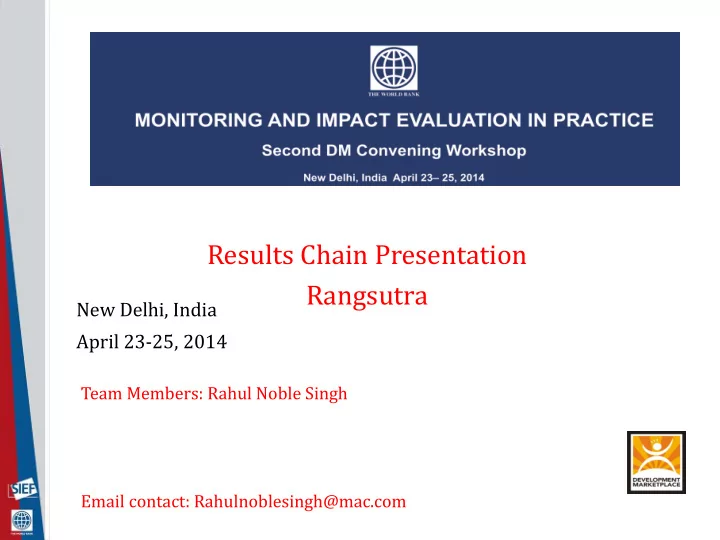

Results Chain Presentation Rangsutra New Delhi, India April 23-25, 2014 Team Members: Rahul Noble Singh Email contact: Rahulnoblesingh@mac.com
Monitoring and (Impact) Evaluation Methods Needs Assessment Impact Evaluation Process Evaluation Analysis of Analysis of Measures How Beneficiary Needs Program Much the Program Implementation Impacts Beneficiaries 1. Why are we doing 1. Services being 1. Health of mothers the project? delivered? and children 2. Who is the target 2. Clients satisfied? improved? population? 3. Services reaching 2. Learning 3. Why do we think target outcomes this approach will population? improved? work in this context? 4. Can we improve 3. More people in 4. What else could cost- jobs? we do? effectiveness? 4. Less poverty?
Simplified Results Chain INTERMEDIATE PROGRAM IMPACT OUTCOMES Theory of Change
1. Program intervention summary Brief description of program activities and outputs: Activities: Aggregation of rural artisans and provision of market linkage Facilitated by: Design Input, Training, Working capital provisions, Quality Control, Marketing. Inclusion of artisans as shareholders in Rangstura. Discussion and creation standards for what “ethical” means in Rangsutra supply chain. Construction of Rangsutra campus and production center. OUTPUTS Outputs: Number of women trained. Estlablishment of Rangsutra campus and production center. Provide flexible home based work opportunities for women, A. Who is targeted? Currently work with over 3,000 artisans (90% women). Mainly women in rural parts of Rajasthan and UP. Aim to work with 10,000 by 2018 B. Where is it conducted? Rajasthan & UP C. When is it conducted? Ongoing
2. Intermediate outcomes and impacts A. Summary of intermediate outcomes: Regular work for artisans through the year Increase number of artisans share holders in Rangsutra Value of products purchased Number of artisans directly involved in the supply chain Sense of value of ones own skills and craft Number of artisans children that continue in trade Summary of key impacts: Increase in income earned from craft based activities Household/Community level income Women status sense of empowerment in households Perceptions of opportunity/aspirations of artisans Development & Preservation of traditional Indian crafts
3. Summary: results chain IMPACT INTERMEDIATE PROGRAM OUTCOME What is the program Impact indicators? Intermediate outcome about? Social and Economic indicators? Inputs development of Artisans Design input in Number of artians Working Capital Monthly income Rangsutra works with Human Resources Household expenditure Number of Rangsutra by women. shareholders Activities ETP used Design workshops Number of states worked Training workshops in Purchase equipment Rangsutra “ethical” Centralised cutting and production QC units Distribute orders Outputs Trained women Mapping of crafts, skills and capacity
4. Data collection: program indicators A. List program indicators to be collected: Daily wage rates – Capacity of artisans groups – – Stage of production cycle – Published ethical standards – B. Method of data collection (e.g. electronic health worker interviews, admin data, etc.): – Field workers using smart phones, – Interns used to contact every share holder. Short questionnaire – C. Frequency of data collection: Each time field visited D. Who will collect the data: Field Workers, Interns
4. Data collection: intermediate and impact indicators A. List indicators to be collected: Monthly Income – Cash income from craft as % of household income – – Attendance at AGM (yes or no) – Bank account openned in artisans name Number of artisans working in Rangsutra supply chain – B. Method of data collection (e.g. electronic health worker interviews, admin data, etc.): Register at AGM Number of payments made by cheque • Smart phones interviews conducted by field staff • C. Frequency of data collection: C. Who will collect the data: • Field Workers
5. Impact evaluation design A. Research question: To what extent does working directly with artisans result in benefit (social & economic) to artisans. What is the implication in terms of achive scale. B. Describe the intervention in the (add treatment arms, if applicable): Treatment: Direct engament with artisans Control: Artisans managed by an entrepreur/intermediary C. Describe the sample size (e.g. 30 schools, 15 pupils each) Treatment: 5 villages Control: 5 villages D. Describe the program assignment rule: (e.g. random selection of schools)
6. Communication of results Key Message 1 (e.g. communicate program impacts on child health) : A. What is the nature of the key message? Importance of artisans being able to earn income from craft. Crafts in india is a such a rich source of cultural and economic resource must be protected and developed. B. Who is the target audience? What communication tools will you use (e.g. brief, video, blog etc.) C. Key Message 2: A. B. C.
Recommend
More recommend